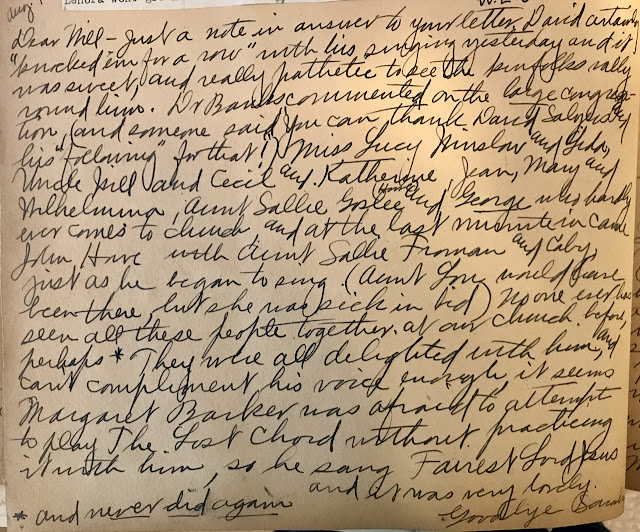Sports
The Salyers males participated in sports, all of them as fans and some of them as players. (I found proof in the letters they wrote to each other and in these bits of memorabilia in the scrapbooks.Students used books of tickets to attend UK athletic events.
 |
| One ticket from the first-semester student admission book |
Fans
who were not students could use this form to apply for reserved seats at home football
games. They would have paid a whopping $9.90 per person, plus the
20-cent fee, to attend all five games.
In the fall of 1932, the Henry Clay Blue Devils traveled to Louisville to meet opponent Male High. The Lexington Herald ran this story:
I've heard family stories about Sarah's son Jim playing football and basketball and son David playing tennis, but I'm still looking for verification in the scrapbooks.
Politics
If you've read posts about Sarah's childhood, you know that she, her parents, and her extended family paid close attention to political issues. Several of her relatives in Carrollton ran for public office. Her children continued the interest in local, state, and national politics. I rarely turn more than 10 pages in most scrapbooks before I come across a mention of political campaigns, platforms, speeches, or elections.
These two items are from 1932. The first appears to be a clipping from a magazine (not identified in the scrapbook). I think the second is a leaflet.
Advertising
Sarah saved many ads. I don't know why she did that, but I'm glad she did. They provide insight into her life and times.

Sarah did the household shopping, and I can picture her checking the grocery ads before venturing to the store. These prices seem low to us, of course, but consider that the average annual salary for those lucky enough to have jobs in Depression-era 1933 was (according to various online resources) about $1,370. Renting a 3-bedroom apartment cost $15 a month, on average. A gallon of gas cost about a dime. Also remember that in 1932-33 Sarah was buying groceries to feed a family of 3 adults, 2 college students, and one teen-age boy.
Notice the half-cent prices. The only references I've found to a U.S. half-penny say the coin was minted from 1793 to 1857. Maybe the half-cent amounts were totaled at the cash register and consolidated into the final price. Apparently, there was no half-penny coin, so I don't know how the clerk handled a single purchase priced with a half-cent amount.
This is one of several ads for retailers marketing to high school boys and college men. In the 1930s (and until not so long ago), men wore suits to athletic events. The Kaufman's store in Lexington ran an ad in the early fall of 1932, offering a Hart Schaffner & Marx suit for $25.
Sarah's husband William Levi Salyers and her son Robert King Salyers worked for the Moore company. Will's job was to find retailers who would display and sell Moore products in their stores. This ad is a sample he showed to prospective sellers. Note the "Your Name and Address Here" near the bottom, with a space for a retailer to promote his own store.
The item at left was on the same scrapbook page as several others advertising an event at the Kentucky Theatre in Lexington. The event brought several nationally-known radio stars to town to perform for a live audience. The event may have been broadcast live to the nation, but I'm hazy on that detail.
The person in this ad appeared in small parts in a few Hollywood movies before he became a radio star at NBC. Jimmy Wallington was the announcer or master of ceremonies for several popular radio shows in the 1930s through the 1950s. The Salyers clan no doubt found radio programs both entertaining and informative. Sarah probably kept this clipping because she often heard Wallington's voice – and possibly because he was part of that event at the Kentucky Theatre.
I speculate that Sarah saved the ad below not because of the product – I don't think she or her daughter ever smoked cigarettes and I saw her sons smoke only pipes and cigars – but because she liked the dress. Ultimate 1930s!
Last but not least, this tribute to Groundhog Day. The item below is a newspaper article clipped from a newspaper, probably published in an afternoon paper, the Lexington Leader, on Feb. 2, 1932.
Based on current weather predictions, I'd say a groundhog who leaves his burrow in Lexington this Friday, Feb. 2, probably won't see his shadow. Will that mean the end of Winter 2018? We can only hope!






















